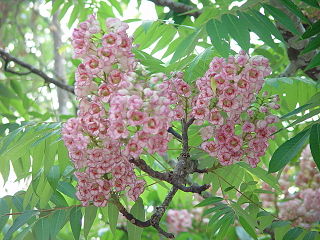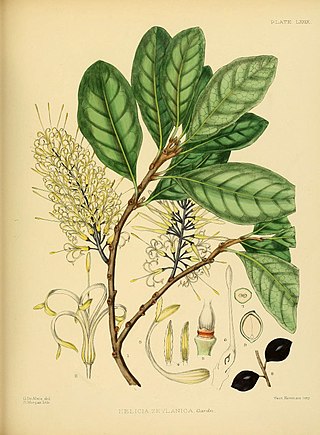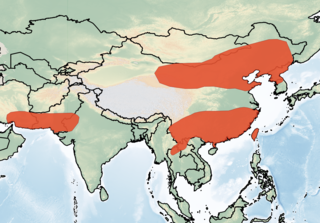
Pyracantha is a genus of large, thorny evergreen shrubs in the family Rosaceae, with common names firethorn or pyracantha. They are native to an area extending from Southwest Europe east to Southeast Asia. They resemble and are related to Cotoneaster, but have serrated leaf margins and numerous thorns.

The conservation status of a group of organisms indicates whether the group still exists and how likely the group is to become extinct in the near future. Many factors are taken into account when assessing conservation status: not simply the number of individuals remaining, but the overall increase or decrease in the population over time, breeding success rates, and known threats. Various systems of conservation status are in use at international, multi-country, national and local levels, as well as for consumer use such as sustainable seafood advisory lists and certification. The two international systems are by the International Union for Conservation of Nature (IUCN) and The Convention on International Trade in Endangered Species of Wild Fauna and Flora (CITES).

Chamaecyparis formosensis is a species of Chamaecyparis, endemic to Taiwan, where it grows in the central mountains at moderate to high altitudes of 1000–2900 m. It is threatened by habitat loss and over-cutting for its valuable timber.

Bretschneidera sinensis, the sole species in genus Bretschneidera, is a rare, 10–20 metres (33–66 ft) tall a monotypic species of tree with large inflorescences. It is found in south and east of China, Taiwan, northern Thailand and northern Vietnam. It is threatened by habitat loss. Because of its relatively recent discovery in Taiwan and Thailand, it is possible that it could also be found in Laos and northern Myanmar. It was named in honor of Emil Bretschneider.

Helicia is a genus of 110 species of trees and shrubs, constituting part of the plant family Proteaceae. They grow naturally in rainforests throughout tropical South and Southeast Asia, including India, Sri Lanka, Indochina, Peninsular Malaysia to New Guinea and as far south as New South Wales.
Neolitsea daibuensis is a species of plant in the family Lauraceae endemic to Taiwan. It is a small semi-deciduous tree that grows in the broad-leaved forests in southern Taiwan at altitudes of 800–1,000 m (2,600–3,300 ft). It is threatened by habitat loss.
Prunus grisea is a species of plant in the family Rosaceae. It is found in Malaysia, the Philippines, Singapore, and Taiwan.

Pyracantha angustifolia is a species of shrub in the rose family known by the common names narrowleaf firethorn, slender firethorn and woolly firethorn. The flowers are white and produce small round pomes and can be orange to red in color. These fruits are astringent and bitter, making them inedible for humans, but they are a food source for birds. The leaves, fruit and seeds contain hydrogen cyanide, the source of the bitter taste. The stems and branches have sharp spines. This shrub is cultivated and grown in yards and gardens as an ornamental plant. It can be used to make hedges for home security. This species is native to China but has been introduced to North America and Australia. It is an invasive species in Hawaii and in other areas.

Pyracantha coccinea, the scarlet firethorn is the European species of firethorn or red firethorn that has been cultivated in gardens since the late 16th century. The tree has small white flowers. It produces small, bright red berries. Its leaves are slightly toothed and grow opposite to one another. The fruit is bitter and astringent, making it inedible when raw. The fruit can be cooked to make jellies, jams, sauces and marmalade. It ranges from southern Europe to western Asia. It has been introduced to North America and cultivated there as an ornamental plant since the 18th century.
Pyracantha atalantioides is a species of Firethorn shrub.

Pyracantha crenatoserrata, commonly known as Chinese firethorn or Yunnan firethorn, is a species of firethorn. It is a short shrub. It is cultivated for its decorative bright red pome fruit. The flowers are white. It survives in warm climates. It cannot tolerate frost, but it can withstand drought. This species originates from central China.

Pyracantha crenulata, the Nepalese firethorn, Nepal firethorn or Himalayan firethorn, is a species of firethorn. The native range of this shrub species stretches from northern Pakistan to northwestern India and China.
Pyracantha rogersiana, the Asian firethorn, is a species of flowering plant in the family Rosaceae, native to western China. Growing to 4 metres (13 ft) tall and broad, it is an evergreen shrub with glossy, narrow leaves, and masses of white flowers followed by small yellow berries 8 mm in diameter. It is grown in gardens, yards, and parks, where it can be used as hedging, wall cover, or in a mixed shrub border. The cultivar 'Flava' has gained the Royal Horticultural Society's Award of Garden Merit.

Cinnamomum osmophloeum, commonly known as pseudocinnamomum or indigenous cinnamon, is a medium-sized evergreen tree in the genus Cinnamomum. It is native to broad-leaved forests of central and northern Taiwan.

The firethorn leaf miner is a moth of the family Gracillariidae. It is native to southern Europe and was probably introduced accidentally into several countries in western Europe on transported plant material. It has now been recorded as far north as Finland and east to Hungary. It was first recorded in Great Britain in 1989. Nash et al. (1995) studied the spread of this species in Great Britain. Besides the "natural" spread of the insect, they found several foci of colonization outside the main distribution range that were undoubtedly due to human activities.

Malinae is the name for the apple subtribe in the rose family, Rosaceae. This name is required by the International Code of Nomenclature for algae, fungi, and plants, which came into force in 2011 for any group at the subtribe rank that includes the genus Malus but not either of the genera Rosa or Amygdalus. The group includes a number of plants bearing commercially important fruits, such as apples and pears, while others are cultivated as ornamentals.

Cunninghamia konishii is an endangered species of tree in the cypress family, Cupressaceae. It is native to southeast China (Fujian), Taiwan, Laos and Vietnam.

The Oriental serotine is a species of bat in the family Vespertilionidae. It is widespread and found throughout Asia.
Shuanglianpi Wetland is a partially protected natural area in Yilan County in northern Taiwan. Situated 470 meters above sea-level, it contains a botanically rich, shallow lake, which, from the perspective of plant species density, is considered to be a wetland with global significance by the Forestry Bureau of Taiwan.














